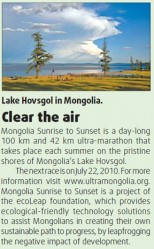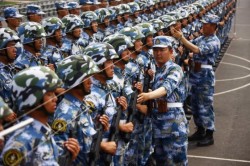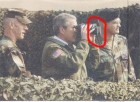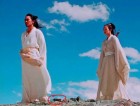Normally I don’t simply copy articles from China Daily, but here I do because I’m real happy the Mongolia Marathon got all this coverage. I just hope next year I can run it again. I mean, the 42k, not the 100k! I miss it…
See also:
https://blog.strategy4china.com/?p=657
https://blog.strategy4china.com/?p=596
8 October 2009 – Going the extra mile – and then some more
By Kathy Hirsch (China Daily)

click to enlarge
Seven years ago my family flew a “goggles and scarf” flight into Hatgal, a northern Mongolian frontier town perched at the southern border of Lake Hovsgol.
We came to Mongolia for a week of camping and mountain biking and, though we didn’t know it yet, an introduction to a Mongolian ultra-marathon.
As we biked up the shore of Lake Hovsgol we saw dozens of fit runners with numbers on front and back. Not what you expect in a region full of mostly nomadic Mongol people who live in gers (Mongolian yurts) and tend herds of horses, camels, cattle and yaks.
The Mongolia Sunrise to Sunset, “the world’s most beautiful 100 km run” was started 11 years ago by a group of friends visiting northern Mongolia who were struck by the remarkable purity of the environment and wanted to help preserve both the park and the local cultural identity. They promote a zero-litter campaign, have bought the national park a garbage truck and contribute as much as possible to the local economy by engaging the local community in the event.
The organizers hire locally, employ horsemen and doctors to supervise aid stations and actively encourage locals to participate in the race. Almost every year Mongolians have placed 1st or 2nd in both the 42 km and 100 km runs for both men and women.
The 42 km and 100 km distances are run along Lake Hovsgol in the national park. It’s the second largest freshwater lake in Asia, at 1,645 m above sea level, and contains about 70 percent of the fresh water in Mongolia.
Looking north, if you squint on a clear day, you can see Siberia. In this absolutely pristine environment the air is clear, the clouds are unbelievable, wild flowers are everywhere and rainbows are a daily occurrence.
The course goes through the woods, over high passes, into marshes, up mossy hillsides, flowery fields and lakeside paths. Runners arrive about four days before the race and spend the time doing practice runs, walks up into the mountains, comparing running strategies and taking lots of photos. The race doctor interviews all the runners and decides who needs a horseman to stay close “just in case”.
At 3:15 am on race day, everyone is awakened by the sound of the Mongolian flute and drum, eats breakfast and dons their headlamps and backpacks. In the middle of summer Mongolia has a very long day, but the sun doesn’t come up until around 5, so the first leg of the race is run in the dark through the forest over roots and mud.
Even though there are aid stations every 12 km along the course, each runner must carry water, food and emergency gear in case of injury. For two years, I’ve gone out the night before to sleep at the second aid station at 25 km with the Mongolian translator, doctor and the horsemen.
This year I was at 76 km. At the 25 km mark the runners were pretty much blowing by with the aid station volunteers quickly filling their camelbacks. It’s a much better social scene at 76 km. We even borrowed a few upholstered dining room chairs from a local ger (we paid them back in cookies, fried donuts and dried bananas) to set up around our aid table. The runners, after 8 to 12 hours of running, were very happy to sit down for a few minutes.
It’s the job of the volunteers to assess the physical status of the runners. Not such a big deal at 25 km, but at 76 km there were blisters to bandage, blood pressures to be taken and the occasional nap. You could feel euphoria rolling off them.
On the trail, many runners seem to fall into a meditative trance that keeps them going. A few have their iPods; most are happy with their thoughts and the gorgeous scenery. Camaraderie also develops along the course, with runners encouraging and waiting for each other. Two British women three years ago seemed to spend the whole race laughing – a great way to wend your way through 42 km.
Every year I’m impressed with the fortitude and dedication of the runners. They range in age between teenagers and septuagenarians. Some are running their first marathon, some are running their 437th.
It’s a very special place with very special people. Maybe it’s a little crazy, but I’ve recently agreed to do the 42 km next year with one of the race organizers. I’m starting to surf the Net for training programs and jokes – we’ll walk it but still… it’s 42 km.









